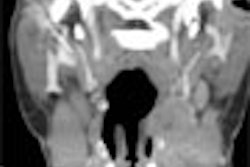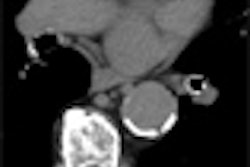A meta-analysis of cardiac CT angiography study results has concluded that more CT detector rows do in fact produce more-diagnostic exams with fewer nonassessable segments. Researchers from Belgium and the Netherlands zeroed in on 54 carefully reported papers documenting four-, 16-, and 64-slice studies, to conclude that CTA has improved markedly since four-slice CTA was introduced a decade ago.
"Since the advent of hardware with multiple detectors, more than one section can be acquired in a single gantry rotation, and this capability has improved the spatial resolution of the images," wrote Dr. Piet Vanhoenacker, Dr. Ruben van Heste, Majanka Heijenbrok-Kal, Ph.D., and colleagues. "Since the advent of scanners with 64 detectors, investigators claim that the diagnostic performance of the technique has improved significantly. To our knowledge, however, no study has statistically proved that this claim is correct."
Study Summary
|
||||||||||||||||
One problem has been the exclusion of coronary segments in earlier studies, because the researchers did not believe they could be assessed, which may have led to overly optimistic reports, they stated. And two previous meta-analyses either did not provide a systematic review or excluded today's standard-equipment 64-detector scanners.
The study examined 54 studies published between 1998 and 2006 that evaluated the diagnostic performance of MDCT scanners in patients with symptoms of coronary artery disease, compared to angiography as a reference standard.
Inclusion requirements included studies with scanners having at least four detector rows, and conventional angiography used as the reference standard in all patients, who were all referred for suspicion of coronary artery disease. In addition, a positive result had to be defined as stenosis of 50% or greater, and the study needed to provide absolute numbers of true-positive, false-positive, and true-negative results, on a per-segment, per-vessel, or per-patient basis. The American Heart Association's 15-segment scheme was used for analysis of the coronary arterial tree.
The researchers calculated summary estimates of diagnostic odds ratio, sensitivity, and specificity. Random-effects models were used to compare the performance of four-, 16- and 64-detector-row scanners. The proportion of nonassessable segments was also calculated. The analysis included 30,775 segments, 2,692 vessels, and 1,474 patients in all.
"Heterogeneity was present among all the studies on all levels, and this presence justifies our choice of a random-effects sROC model," they wrote. "Results of the per-patient analysis showed the least heterogeneity (I2=65.95%), whereas results of the other two analyses showed considerably greater heterogeneity (per-vessel I2-82.09%, per segment I2=94.04%).
Of the 54 studies that made the cut (134 papers were excluded), 22 were performed with four-slice scanners, 26 with 16-slice machines, and six with 64-slice scanners.
The pooled sensitivity and specificity for detecting a stenosis greater than 50% per segment were 93% (95% CI: 0.88, 0.97) and 96% (95% CI: 0.81, 0.88) for 64-detector-row CT angiography, 83% (95% CI: 0.76, 0.90) and 96% (95% CI, 0.95, 0.97) for 16-detector-row CTA, and 84% (95% CI: 0.81, 0.88) and 93% (95% CI: 0.91, 0.95) for the four-detector-row CTA studies.
A meta-regression sROC analysis showed that the relative diagnostic odds ratio was significantly greater with a 64-slice scanner compared to four-detector-row CT (odds ratio, 3.95; 95% CI: 1.20, 12.94).
The meta-regression sROC analysis also showed that a number of other variables, including exclusion of nonassessable segments, table feed, rotation speed, mean calcium score, contrast agent concentration, scan duration, and patient age independently influenced the log of the diagnostic odds ratio with p < 0.1.
Finally, a multivariable meta-regression sROC model showed that 16- and 64-detector-row CT had a significantly greater relative diagnostic odds ratio compared to four-detector CT. Other significant predictors were the proportion of nonassessable segments and the contrast agent concentration (p < 0.05).
Analysis using the 15-segment American Heart Association model resulted in a low prevalence of coronary artery disease in the total population of segments, inasmuch as going from per vessel to per-segment results implies an increased opportunity for false-negative results, they noted.
"The pooled sensitivity and specificity and overall diagnostic performance expressed in the log of the diagnostic odds ratio of four-, 16-, and 64-detector CT angiography for detection of at least one significant stenosis per segment, per patient, or per vessel showed that with an increasing number of detectors used in the newer generation of CT scanners, sensitivity, specificity, and the log of the diagnostic odds ratio increased."
The decrease in nonassessable segments in the newer scanners represents a significant improvement in technology, they stated. "This is of major importance, because noninvasive imaging of the coronary arteries requires that the complete coronary arterial tree can be visualized with excellent sensitivity and specificity in order to become an alternative to invasive coronary angiography," the authors wrote.
In discussing the limitations of their study, the authors noted that they were unable to show that calcium score significantly influences diagnostic performance and the proportion of nonassessable segments when adjustments are made for other predictors. This likely resulted from the low number of studies (n = 10) in which calcium results were reported.
Also, publication bias -- the tendency to publish positive reports -- suggests that the overall results with the technology could be less optimistic than the studies reported. And because the studies used different reporting methods, relevant data from each analytical level -- per vessel, per segment, per-patient -- were not available for each study.
Finally, the high prevalence of coronary artery disease in the source population means that the results are not generalizable to a lower-risk population, they stated.
"With the newer generations of multidetector CT scanners, the diagnostic performance for the assessment of coronary artery disease has significantly improved, and the proportion of nonassessable segments has decreased," the authors concluded. "How this clinically relevant imaging technology will fit into the diagnostic strategy for patients with known coronary disease and those who are suspected of having it remains to be determined."
By Eric Barnes
AuntMinnie.com staff writer
August 15, 2007
Related Reading
CTA finds serious incidental findings after CABG surgery, August 6, 2007
JAMA study: Coronary CTA poses substantial cancer risk in select patients, July 17, 2007
Triple-rule-out CT yields even contrast enhancement, January 22, 2007
Cardiac CT yields significant extracardiac findings, November 26, 2006
Cardiac CT evolves on multiple fronts, November 20, 2006
Copyright © 2007 AuntMinnie.com



















